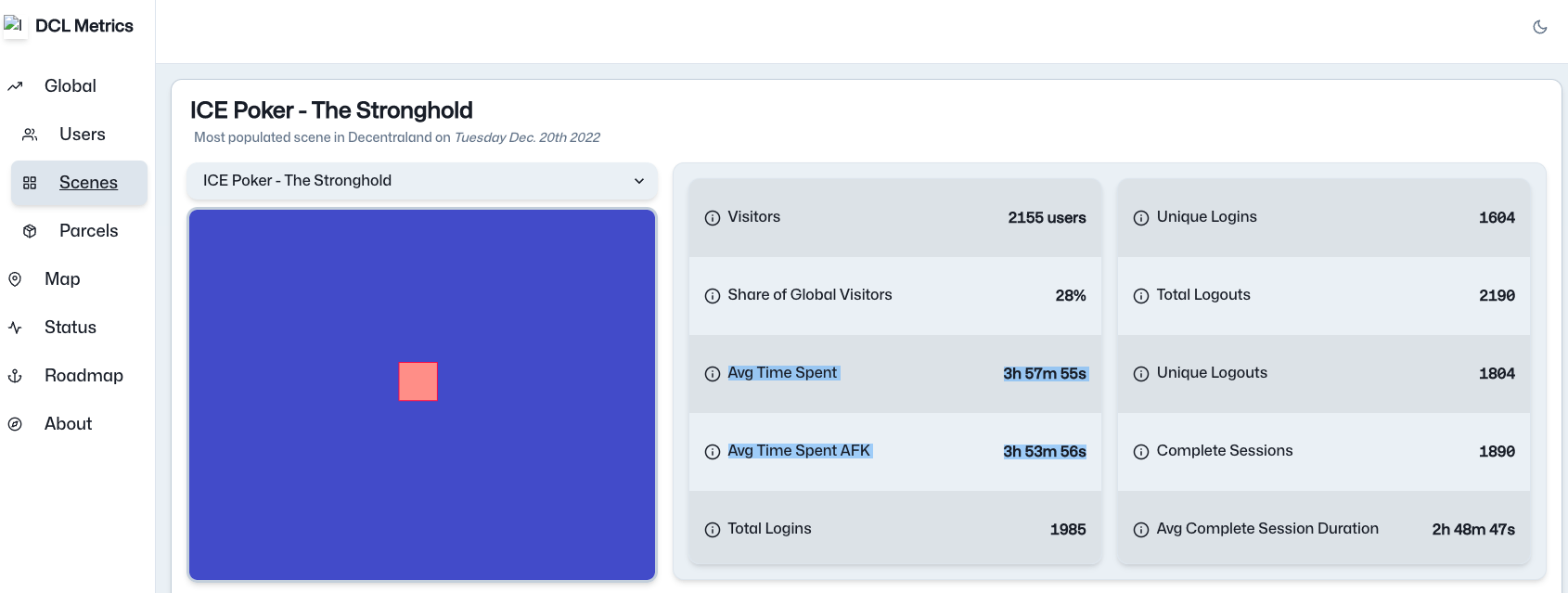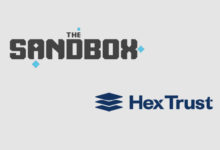The Final Word on Decentraland’s Numbers

Key takeaways:
- Determining the population of Decentraland on an average day, or at events like its Music Festival, is a difficult task because the metaverse is fraught with bots.
- CoinDesk worked with data company Atlas Corp. to create a number that reflects what we believe is an accurate count of active players in this metaverse.
- 810: The active population of Decentraland on an average day, according to our research.
- 3,668: Number of active users with a non-fungible token in their wallet at the Metaverse Music Festival.
Is it 38? 650? 7,000?
It’s tough doing a census of the metaverse.
Try as we might, CoinDesk, in the eyes of Decentraland’s fans, just couldn’t get the numbers right.
Metaverse platforms such as The Sandbox and Decentraland present a challenge of sorting bots from real people, and then even real people can be inactive or AFK, short for “away from keyboard” for hours, days, even weeks. One way to filter out bots is to filter users by those with non-fungible tokens (NFT), which also weeds out “tourists” who pop in for a quick look and leave without meaningful interaction. In addition, it can be argued that those users with NFTs matter the most because in a Web3 metaverse like Decentraland, users with NFTs such as ones that denote ownership of real estate in decentraland (LAND) or wearable items that unlock some of the more popular experiences like ICE Poker are the ones who are most active in the platform, and certainly are the most valuable to the ecosystem’s success.
Another challenge in determining how many active users there are in Decentraland, despite there being an abundance of open-source data available on the blockchain, comes down to the fact that Decentraland and MANA token holders have a vested interest to make sure this number appears as large as possible. Certainly, publishers including Electronic Arts or Activision Blizzard want to see a high level of active players on their games such as Battlefield or Call of Duty, but their stocks have other fundamentals behind them and don’t rely on the rise and fall of a single game or platform. These games also don’t have the problem of idle bots that hang out to inflate the player base.
Hop into a session of either of these traditional games and you’ll be greeted with action from the moment you arrive. But log into Decentraland and you’re dropped into an apparent ghost town. There are players on there, and more in certain areas, but are they active?
So in order to figure out just how many active users there are on the platform we used every available tool out there to try and track this down, from DappRadar to Atlas Corp.’s data repository (which powers DCL-Metrics), to the open-source Catalyst Nodes Monitor, DappRadar and Nansen. We even tracked how many players went to the much-hyped Metaverse Music Festival thanks to Atlas Corp.’s data.
It’s important to remember that with one exception, which we’ll address later, these aren’t CoinDesk’s numbers. We’re reporting them directly from the source.
Here are the results:

Rob Dippold, partner and president of Digital Strategy for Primary Wave Music, the company that partnered with Crosby’s estate to host the activation, told CoinDesk that the 10 day-long activation aims to bring a new life to Crosby’s work and enable fans “to easily experience the wonders of a metaverse for the first time.”
While the “wonders” may come and go, all pop-ups must come to an end. So the question remains: While these ephemeral experiences in the metaverse may attract new users, what entices them to come back?
Atlas Corp.: Forcing transparency on Decentraland
Atlas Corp.’s numbers:
- 810 (Oct. 7, 2022 snapshot)
- 3668 (Metaverse Festival, NFT holder)
- 6,080 (Metaverse Festival, no NFT)
One of the loudest critics of CoinDesk’s reporting of DappRadar’s numbers was Miami-based Atlas Corp., calling it misinformation. In the initial aftermath of CoinDesk’s report on DappRadar’s numbers, Atlas Corp. said that there were 8,000-10,000 daily active users on Decentraland.
While an article by PC Gamer called out that DCL Metrics (where Atlas Corp.’s data is published) is “a platform created by Decentraland to report user data, so take it with a grain of salt,” that isn’t entirely accurate and lacks an understanding of how decentralized autonomous organizations (DAO) operate and fund things.
Atlas Corp. and DCL Metrics are both funded by grants from the Decentraland DAO that were proposed and voted on by holders of one of the DAO’s governance tokens, MANA, NAMES or LAND. This isn’t the same as Decentraland’s executives funding it themselves – it’s an arm’s length operation.
In fact, as Atlas Corp.’s co-founder, Avi Aisenberg, explained in an interview, it was a bit of an uphill battle to get the Decentraland Foundation to respect the need for transparency.
“If I had a single word to describe the Foundation it is opaque, which as you can imagine makes it difficult to build relationships. There is little public information on how it’s structured, operated, funded, etc. Over the course of two years, through our own investigative research, we’ve been able to learn a lot and it’s only added fuel to the Atlas Corp. fire,” he said via email.
Aisenberg said the Decentraland Foundation didn’t view transparency as important in the past, and Atlas Corp. effectively goaded it to begin sharing data – a forced transparency that benefits the community.
“Our methods are known yet we’ve had to stand our ground on multiple occasions to ensure access to the data is open, preventing breaking changes that would ultimately lock out the community from having the same level of access to the data as the Foundation and the DAO node operators,” Aisenberg continued. “I often wonder what it is that team was up to in the past.”
Crunching their numbers
When covering numbers from DappRadar and other tools, CoinDesk reported exactly what was being presented. But for Atlas Corp.’s numbers, more work was required. This is the exception to directly presenting the source’s raw numbers we mentioned at the start.
While Atlas Corp. advertises 8,000-10,000 active users that number needs to be picked apart in order to get an accurate figure of active users. There are a few red flags, including the huge variance of the 8,000-10,000 figure from the other data sources, as well as the number of “Marathon Users” on DCL-Metrics, which shows a large group of users are spending close to 24 hours on the platform. Finally, there are a high number of users that are listed as “away from keyboard” (AFK) in some of the scenes, including the most popular location, ICE Poker:

ICE Poker scene data (DCL Metrics)
So in order to account for all of this we need to perform some filtering on the raw JSON (a type of database file used for web applications) provided by Atlas Corp. of a snapshot from Oct. 7, 2022, which contained a list of wallet IDs and time on site. We used a Python Script to convert this into an Excel file while extracting user names and the presence of NFTs and aligning this into columns.
In order to find a more realistic number, we wanted to filter the following:
- Figuring out the time spent “away from keyboard” (AFK). We did this by subtracting the average time spent from the average time spent away from keyboard, which DCL-Metrics provides in its ‘scenes’ section. We then averaged it out across the entire set of scenes. The result is 24 minutes, which we rounded up to 25.
- The presence of an NFT in a Decentraland wallet is also an effective proxy of who is really an active user, as earlier noted (an NFT is needed to play ICE Poker, for example). While this would eliminate some of the casual users that treat Decentraland like a Web2 product, it would also eliminate many of the bots.
- After applying filters via Google Sheets for both of these attributes we got a number back: 810.
A Google Sheet demonstrating all of our work is available to review here.
For Decentraland’s Music Festival we took a slightly different approach. Given that this event also serves as a «sales funnel» for Decentraland, we decided to generate numbers that include those that have and do not have an NFT in their wallet.
- Atlas Corp. provided us with JSON files in a similar structure to the Oct. 7 snapshot that listed out the wallet ID and time spent across all of the scenes (there was an area called Main Stage and On Site) and the multiple dates.
- We applied the same Python script to sort them into an Excel sheet and then to Google sheets. From there we used the same time filters to eliminate those that spent over 25 minutes and those that did/did not have an NFT. This time range was still a reasonable metric as most of the sets were 20-30 minutes long.
- Our data shows that there were 3,668 users at the festival who also had an NFT.
- The data shows that there were 6,080 users in total when the NFT filter was not applied. This larger number is expected given the high profile of the event.
Nansen and Catalyst Nodes Monitor
The other two tools that we used to determine the number of active users on Decentraland are Nansen and Catalyst Nodes Monitor.
Nansen’s Entity Billboard tool attempts to track the number of active users on individual platforms, everything from Uniswap to LooksRare, by looking at the activity on their respective smart contracts. Nansen stresses that this tool is very much in beta. In total, it tracks 3553 smart contracts across Ethereum and Polygon.
During our snapshot period, Nansen reported that there were 526 users on Decentraland on Oct. 7.
While some of the same criticism for DappRadar’s numbers could be applied, the fact that it seems to align with the number from Atlas Corp. would suggest that DappRadar’s numbers are more accurate than its critics suggest. After all, the key to finding out any number is the process of triangulation.
On the other hand, Catalyst Nodes Monitor takes a slightly different approach. It tracks the load on each of its servers which it calls catalysts. Atlas Corp.’s Aisenberg did provide some criticism of this method as there are nodes that remain untracked by the platform, so the real figure is possibly higher than captured.
Catalyst Nodes’ numbers show there were 600 users on Decentraland as of Oct 7. This figure comes from a scraped average across the morning, evening, and overnight.
A final note: The fun factor
Throughout this process, we tried hard to look at Decentraland from purely a quantitative, not qualitative, perspective. After all, taste is subjective but numbers don’t lie.
But it’s hard not to think about Decentraland in the qualitative: Is this a good game?
When speaking with Atlas Corp.’s Aisenberg, he likened it to «Westworld.»
“On the most fundamental level, you have people jumping into worlds, and interacting with scenes that are built by other people. They don’t know how it works on a technical level necessarily nor do they care, and they are able to walk around and choose their adventure,” he told CoinDesk in an interview.
In Westworld’s fictional robotic playground, tourists can unleash their beastly and carnal desires to kill or fornicate to their heart’s desire. Reviews of the show equated it to an edition of Grand Theft Auto set in the wild west, with the show exploring hedonism and the horror of virtualized reality.
Though in Decentraland, you can’t do anything like that.
Whereas Grand Theft Auto V built a living simulacrum of Los Angeles and opened it up to online battles and the ability to complete missions with friends (it even has an online economy that’s currently suffering from inflation), Decentraland feels limited. Its activities are limited to walking around, playing poker, perhaps popping into a brand activation and going to an online concert. At the concert, you watch a video with friends in 3D or see a crudely-rendered concert animation that looks like it’s from the Playstation 2 era. We must admit our team enjoyed briefly jumping around together in a virtual winter wonderland, but we’re also unlikely to plan another group activity in Decentraland.
As of September 2021, GTA V has earned its developer $6.4 billion in revenue across 150 million units sold, with yearly expansion pack downloadable content, as players are still obsessed with dishing out wanton violence in its virtual city. Decentraland, at its peak when the token was worth $5.85, had a market cap of nearly $10 billion despite gameplay that most players would find boring. Now, with 93% of its value evaporating, that market cap is closer to $575 million and token with 30 cents.
CoinDesk got a lot of flack from crypto Twitter for reporting on the number of users on Decentraland, but even if after our analysis, you still believe in the highest numbers of 10,000 daily users, there’s still a long way to go to achieve the kind of mass success of games like GTA or Call of Duty, or mass adoption of online worlds like Roblox and Minecraft.






 Bitcoin
Bitcoin  Ethereum
Ethereum  Tether
Tether  USDC
USDC  TRON
TRON  Dogecoin
Dogecoin  Cardano
Cardano  Bitcoin Cash
Bitcoin Cash  Chainlink
Chainlink  Monero
Monero  LEO Token
LEO Token  Zcash
Zcash  Stellar
Stellar  Litecoin
Litecoin  Hedera
Hedera  Dai
Dai  Cronos
Cronos  Tether Gold
Tether Gold  OKB
OKB  Ethereum Classic
Ethereum Classic  KuCoin
KuCoin  Gate
Gate  Algorand
Algorand  Cosmos Hub
Cosmos Hub  VeChain
VeChain  Tezos
Tezos  TrueUSD
TrueUSD  Dash
Dash  Stacks
Stacks  IOTA
IOTA  Decred
Decred  Basic Attention
Basic Attention  Theta Network
Theta Network  NEO
NEO  Synthetix
Synthetix  Qtum
Qtum  Ravencoin
Ravencoin  DigiByte
DigiByte  0x Protocol
0x Protocol  Nano
Nano  Zilliqa
Zilliqa  Siacoin
Siacoin  Numeraire
Numeraire  Waves
Waves  BUSD
BUSD  Status
Status  Enjin Coin
Enjin Coin  Pax Dollar
Pax Dollar  Ontology
Ontology  Lisk
Lisk  Hive
Hive  Steem
Steem  Huobi
Huobi  NEM
NEM  OMG Network
OMG Network  Bitcoin Gold
Bitcoin Gold  Augur
Augur  HUSD
HUSD